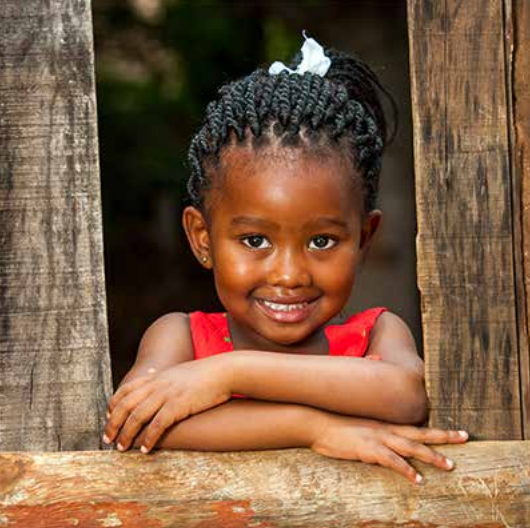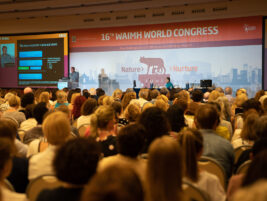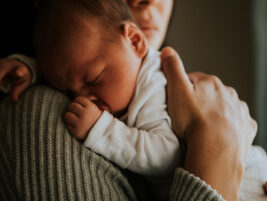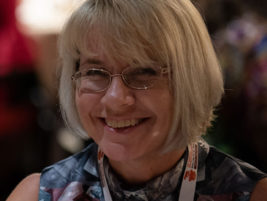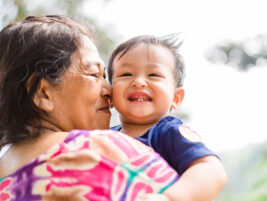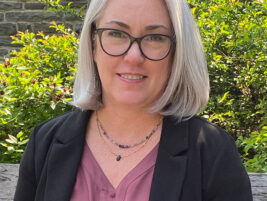Infant mental health as a field of focus in South Africa has been gathering momentum in the past two decades. The first ever infant mental health conference to be held in South Africa was arranged by Professor Astrid Berg and held in Cape Town in 1996. The second was when Cape Town proudly hosted the 13th Congress of WAIMH in 2012. October 2015 saw the first infant mental health conference held in Johannesburg, South Africa.
Organised by the Gauteng Association for Infant Mental Health (GAIMH-SA: a WAIMH affiliate), the conference was co-hosted by the University of Witwatersrand’s School of Human and Community Development and funded by the DST-NRF Centre of Excellence in Human Development. The aims of the conference were to highlight infancy as a crucial developmental period amongst practitioners, to promote early interventions targeting perinatal mental health, and to encourage multidisciplinary collaboration. The non-governmental organisation (NGO) sector was also included, as much of the work in this field in South Africa is being carried out by these organisations, often in collaboration with various University Departments. Mother-baby home visitors gave moving case study presentations that highlighted the everyday realities of poverty and the effects of trauma that many South African mothers and babies manage. These presentations brought faces and stories to the research subjects in the more academic presentations.
Due to student protests regarding fee increases, the conference venue had to be changed at a week’s notice. Amid jokes about scheduled hospital births turning into unplanned home births, the conference ‘birth’ was moved from the University of the Witwatersrand to Ububele, a Johannesburg NGO. The inconvenience was managed in true African style, with little fuss, and an understanding that the student protests were a hopeful example of youth who can speak for themselves, asking for their needs to be met. Ububele was a gracious host and, as an NGO instrumental in highlighting the importance of intervention during infancy, a fitting venue.
Research in sub-Saharan Africa has highlighted poor child development outcomes associated with deprivation (see Lancet special edition on child development, 2007). Early intervention is required in order to facilitate positive, long-lasting treatment effects. However, as is the case in many developing countries, funding in South Africa focuses on decreasing HIV infection and infant mortality rates, as opposed to the promotion of infant mental health (IMH). High rates of HIV infection in sub-Saharan Africa continue to pose a threat to the well-being of infants born to HIV-infected mothers. Plenary presenter, Peter Cooper (Academic Head: Paediatrics and Child Health, University of the Witwatersrand) gave an overview of progress in the area of infant HIV infection in last 25 years. Following the historic South African Constitutional Court Ruling of 2002, that legislated the introduction of antiretroviral therapy (ARVs) to prevent mother to child transmission (MTCT), rates of MTCT have decreased from approximately 30% in the year 2000 to recently estimated rates of approximately 3%. Exclusive breastfeeding is encouraged as mothers are provided with ARVs for the duration of breastfeeding. The current early provision of ARVs for HIV-infected infants has resulted in a decrease in infant mortality and improved developmental outcomes. However, Joanne Potterton’s (Physiotherapy, WITS) presentation highlighted the continued risk facing HIV infected infants. While early ARV treatment was found to contribute to some developmental gains, infected infants remain developmentally delayed when compared to uninfected infants. She presented findings from three studies on HIV encephalopathy that compared the developmental levels of HIV-exposed and infected (HEI) and HIV-exposed uninfected (HEU) infants, finding that compared to HEU infants, infected infants demonstrated significant delays in all areas of development from four months of age. These developmental challenges of infancy, despite adequate viral suppression, were found to extend into childhood, with HEI pre-school age children continuing to demonstrate increased rates of developmental delay.
Amina Abubakar (Psychology, Lancaster University, UK; Centre for Geographic Medicine Research, Kenya), in her invited plenary, presented her research on executive function (EF) in the context of HIV exposure. EF regulatory control plays an important role in both cognitive and social development, and hence academic achievement. Functional brain imaging and scans have found that EF-related brain regions (predominantly pre-frontal cortex) are especially susceptible to HIV-related damage. Abubakar highlighted the dearth of research in African populations and stressed the importance of early detection of these dysfunctions in at-risk paediatric populations, in order to identify those children in need of early intervention. She also delighted the audience with descriptions of the difficulties a researcher faces when using biscuits as enticements for toddlers during assessments.
ARVs also came under the spotlight. Tarryn Stevens’ (Speech Therapy, WITS) study comparing the effects of Nevirapine and Efavirenz on language development in HIV-exposed uninfected infants exposed to either Nevirapine or Efavirenz through MTCT, found the mean language scores of infants exposed in utero to Nevirapine to be significantly higher than those exposed to Efavirenz. No correlations between the child’s language abilities and maternal factors were found. These presentations highlighted the progress made in the field of paediatric HIV, but also the gaps in knowledge and questions that remain with regards to the treatment of paediatric HIV.
The increasing homogenisation of the field of infant development is a recent concern in the literature (Pence & Nsamaneng, 2008). The notion of the ‘global child’ and a ‘one size fits all’ model of parenting were challenged at the conference. Gillian Mooney (University of the Witwatersrand) presented a meta-analysis of the journal Developmental Psychology, from the year 2000 to the present, and concluded that much of what we ‘know’, in the developmental psychology literature, is based on the experiences of white, middle-class American children and their mothers. She found the focus to be on older children (predominantly adolescents), and very little on the roles of fathers was noted.
The conference did not follow this trend and a number of presentations highlighted the importance of culture and context in understanding parent-infant dynamics and in the development of interventions. Astrid Berg’s (University of Cape Town and Stellenbosch University) plenary presentation emphasised the presence of a number of ‘potential barriers, such as language, different world cosmologies, as well as hardships of daily living’ that exist in multicultural intervention contexts. She highlighted the importance of reflective practice in clinical work. In order to allow the dynamics of cases to be uncovered and understood, she recommended a stance of inner and outer reflectiveness and detailed observation. A number of presentations considered local contexts, understandings and practices around infancy and child-rearing in a reflective manner. Katherine Bain (Psychology, University of the Witwatersrand) and Jade Richards (Ububele psychologist) presented on levels of knowledge regarding the relational needs of infants amongst mothers from a low-income Johannesburg Township, Alexandra. Strong culturally-linked inclinations towards the denial of any negative maternal affect, post-birth, were found, such as ‘babies are gifts, mothers cannot be sad’. This highlighted the need for further research in order to determine possible associations of this denial of negative affect to rates of maternal depression found in higher-risk South African populations (36%). These rates are three times those found in developed countries (10-12%) (Hartley et al., 2011). The need to increase parental knowledge regarding infants’ sentience and awareness was also highlighted in a presentation by Katharine Frost (Head of Ububele’s Parent-Infant Programme) and Zanele Vilakazi (Lay Counsellor, Ububele). They explored the introduction of the Brazelton Neonatal Behavioural Observation (NBO) to highlight the infant’s capabilities in parents’ minds, in a local Johannesburg township setting.
An example of contextually relevant intervention was a presentation by Jade Richards and Nicola Dawson (Ububele psychologists), who noted that the importance of supporting the mental health of the primary caregivers of infants, that is recommended in parent-infant intervention, often neglects to include caregivers of infants that work in shelters for abandoned infants. The impermanence of relationships between care workers and infants in shelters has been highlighted in the literature as highly problematic, yet is often unavoidable as workers retain a defensive distance to protect themselves against multiple losses as babies are adopted, move homes or care workers change employment. It can seem counter-intuitive to care workers and professionals alike to encourage bonding in these cases, but it is known that this is what the babies require. Richards and Dawson explained how the therapy space encourages thoughtful reflection around the infant’s experiences, traumas and individuality, in addition to the influences of the caregiver’s own attachment history on the relationship. It also provides support to the caregiver and the infant around feelings of anticipated and real loss. Since the service is new, it also provided a chance to think through the possibilities of using the therapy space as one in which the loss and change-over of caregivers is managed. Questions around the possibilities of continuing the space with new caregivers when current caregivers leave were considered.
Ububele’s Baby Mat service (Frost, 2012), was another example of contextually responsive intervention. The Baby Mat service consists of a literal mat on the floor of (currently seven) Baby Wellness clinics in Alexandra and Hillbrow, staffed by a dyad consisting of a psychologist and a trained counsellor/translator. The dyad invites mothers in the waiting room to bring their infants to sit on the mat to discuss any concerns they may have. The dyad then waits on the mat. Over time, the service has grown as mothers have become accustomed to the service and see it in use. The service functions as an effective short-term intervention, providing mothers with a space to reflect around their experiences and those of their infants, and as a screening and referral service for cases requiring additional intervention. Presenters explained how staff on the Baby Mat adopt a non-judgmental stance and that ‘the culturally-informed frames of reference’ that are brought by mothers are ‘neither elevated nor dismissed’, but rather engaged with from a wondering and curious stance, which ‘helps those who visit the Baby Mat to find symbolic meaning in the presenting problem by exploring the internalised meanings of cultural attributions and reflecting on these’. The baby mat presentations highlighted the complex layers of meaning-making involved in cross-cultural interventions that involve multiple cultural, language and racial configurations on the mat. ‘Good-enough’ mothering as a contextually-bound and culturally-informed conceptualisation was explored and the importance of considering mothering in light of historical racial experiences when intervening was emphasized. It was demonstrated that meaning-making is a collaborative process and the importance of a multicultural supervision group was highlighted.
The complexities of the navigation of cultural differences was highlighted in Cora Smith’s (Chief Psychologist; Charlotte Maxeke Hospital; University of the Witwatersrand) plenary presentation that gave an account of the ethical dilemmas of attachment and custodial rights in baby swop cases. A case was presented where infants were given to the incorrect parents after birth. The mix-up was discovered approximately three years later after a paternity test was conducted in a child maintenance case. These parents then sued the hospital and petitioned for the return of their biological child. The presentation captured the intensity of conflicting emotions and opinions in both sets of parents, with one set wishing to return their child and have their biological child returned, and the other wishing to keep their ‘wrong’ child. The immense task of balancing the best interests of the children and their respective parents in this case, was complicated by various parental conflicts and custody issues, in addition to parental cultural beliefs. A thoughtful account of the process of differentiating between ‘valid’ cultural beliefs and those manufactured for the purpose of manipulating legal outcomes was addressed. In this case, the court appointed a ‘cultural expert’ to comment on the beliefs regarding ancestors requirements that were presented by parents in order to give due consideration to those beliefs deemed to be pertinent to the case. Importantly, the court’s finding that the children’s attachment needs (for their psychological parents) required prioritising over the biological parents’ constitutional rights for control over their biological offspring, was a recognition of children’s needs for consistent, on-going relationships to caregivers by the South African courts. The children remained with the parents with whom they had been since birth, with supervised visitation by biological parents.
Presentations on the two local Mother Baby Home Visiting Programmes (one in Cape Town and one in Johannesburg) also highlighted the need for cultural and contextual sensitivity. Mireille Landman (Parent Centre, Cape Town) presented on the lessons learned from 20 years of running a community-based parent-infant home visiting attachment intervention in Cape Town, Thula Sana. Her account of emotionally difficult, yet essential work with mothers and infants living in contexts of poverty, substance abuse and trauma, being done by underpaid lay counsellors, supported by supervisory staff burdened by funding uncertainties, provided insight into the challenges faced by these organisations. The fact that much of the early intervention in South Africa is carried by non-governmental organisations (NGOs) who function under uncertain financial circumstances, highlighted the tenuous situation of services for children under three and their parents in South Africa.
However, there is a growing recognition of the need for infant mental health services in the public health sector and there were a few presentations that evidenced this. The formativeness of infancy in the formation of neurodevelopmental trajectories, especially within third world settings where children are surrounded by epigenetic risk factors was highlighted by presenters from the public health sector. Helen Clark (Head: Child and Adolescent Psychiatry, Baragwanath Hospital, University of the Witwatersrand) emphasized the effects of deprivation on parenting and highlighted a tendency toward an external caregiver locus of control in parents presenting with their young children at Baragwanath Hospital. The tendency to place the focus on the child as the problem, as opposed to the child-caregiver relationship, increases the demand for a child based intervention. The need for interventions that focus on the parent-infant relationship was emphasised and Dr Clark announced the establishment of a 0-3 clinic at Baragwanth Child Psychiatry Unit from 2016. Janice Cowley (Occupational Therapist), Bianca Veira (Speech and Hearing Therapist) and Melanie Esterhuizen (Psychologist) from South Rand Hospital, in southern Johannesburg, highlighted the complexity of biopsychosocial influences on development and stressed the importance of transdisciplinary treatment. They described the development of an early intervention multidisciplinary team, comprising Speech Therapy and Audiology, Occupational Therapy, Psychology, Physiotherapy and Dietetics, at the hospital. Monthly visits to the team allow for infants and caregivers to receive a number of treatments in the same visit, and the shared space and effective communication between disciplines allows for easy cross-referrals. The service was shown to minimise travel costs for patients, improve service delivery and outcomes, to empower parents, and to provide cross-discipline professional education for professionals.
A number of presentations also featured creative and culturally sensitive interventions in high-risk neonatal and paediatric intensive care units. Lynn Preston (Psychology, North West University) presented a review of studies highlighting post-traumatic stress reactions in parents of hospitalised infants. She presented evidence for the provision of support for parents with infants in neonatal intensive care units, with benefits for parents and professionals in these settings. Kerry Brown and Carla Brown (Occupational Therapy, Red Cross War Memorial Children’s Hospital, University of Cape Town) presented the development of a parent group in the pediatric intensive care unit at the Red Cross Hospital to provide psychosocial support for parents and education on the neurodevelopmental needs of their infants. Novel methods of working with language and education diverse groups were presented. A study demonstrating the effectiveness of Kangaroo Mother Care (KMC) as opposed to standard incubator care, with regards to interactional patterns between mothers and infants was presented (Sian Green & Warwick Phipps: psychologists). The mothers in the KMC group, which encouraged skin-to-skin infant carrying, demonstrated significantly more effective interactional patterns with their infants than those in the incubator group. Miemie du Preez (Neonatology, Stellenbosh University, Tygerberg Hospital) highlighted the need to encourage maternal verbal engagement with premature infants, citing numerous studies that demonstrate shared reading (parents to infants) as a highly efficient way of safeguarding children from school failure. She presented an inspiring account of the development of a reading programme in the Tygerberg Hospital neonatal intensive care unit, using local languages and rhymes to create books for mothers to read to their infants during their hospital stay. Mark Tomlinson (Psychologist & Professor, University of Stellenbosch) also presented on a book-sharing clinical trial running in tandem with the Thula Sana Mother-Baby Home Visiting Programme in Cape Town and due to start in Lesotho, a country neighbouring (locked within) South Africa.
A number of international speakers contributed to the conference. While Alessandra Piontelli (University of Milan) was unfortunately unable to travel at the last minute, her presentation was conducted via ‘voice over powerpoint’. Her lively sense of humour and fascinating visual material made up for her lack of presence, as she challenged a number of popular notions about foetal life and emphasised that our knowledge of foetal experience is still very uncertain. Louise Emanuel (Tavistock Clinic, London) presented clinical work with families in which the toddler’s hatred of his/her new sibling is murderously intense. She explored states of persecutory anxiety, sadism and rage in toddlers towards a younger sibling and the technical dilemmas faced when these conflicts are enacted in the therapy room. Her descriptions of the manifestation of this rage in the therapy room captured the extreme paralysing countertransference elicited, which she explored drawing on Donald Meltzer’s (1968) paper: ‘Terror, persecution and dread’. Using Freud’s (1915) description of how ‘the shadow of the object falls on the ego’, Emanuel linked these sadistic attacks to the trans-generational transmission of unresolved parental loss and trauma. She explored how parents’ own experiences of repressed rage can influence sibling fierceness and parents’ reactions to their children’s behaviour, for example, parents who project their rageful and sadistic impulses into their children, while remaining passive themselves, create a dynamic where the parents become victims alongside the new baby while the older child plays the role of tormentor. This kind of dynamic, awash with persecutory anxiety, can create collapses in strategy and a paralysis, in both parents and therapist, of which the therapist must remain mindful.
Often absent in the literature and in the therapy room, fathers were also considered in a number of presentations that ranged from the theoretical to the applied. High rates of ‘father absenteeism’ have been highlighted in both local and international literature (Magruder, 2010; Posel & Devey, 2006; Richter & Morrell, 2006) and many reasons have been postulated for these shifting paternal roles. Tessa Baradon’s (Anna Freud Centre, London; Visiting Adjunct Professor, University of the Witwatersrand) paper moved away from a ‘father-blaming’ stance and asked pertinent questions with regards to the marginalisation of fathers. She questioned the positioning of fathers in the theory, as a support to the mother and infant, rather than as a subject with a relationship with their infants in their own right, and highlighted the tendency of practitioners themselves to marginalise fathers in the practice of parent-infant psychotherapy. The exclusion of men from more ‘nurturing spaces’ led to interesting discussion and it was questioned whether the increasing feminisation of the helping professions was another manifestation of this exclusion of men. Baradon emphasised the need for a paradigm shift that engages fathers and invites them back into the caregiving space.
Changing constructions of gender and family structure were considered in Nick Davies’ (University of the Witwatersrand) presentation on paternal function, based on a paper co-authored with Gillian Eagle (University of the Witwatersrand). He proposed a need to avoid conflation of the paternal function with maleness and masculinity and to consider the paternal function as distinct from the role of the father. He proposed that when separated from the notion of fathering, a space is opened up ‘to consider alternative sources of paternal functioning and the related importance of the position of third persons or objects in infant development’. In the context of high levels of father absenteeism, the idea that the ‘paternal function’ could be performed by people in the infant’s life other than the father is heartening.
Common to Africa is the notion of multiple caregivers. Nicola Dugmore’s (Chairperson of GAIMH-SA) presentation noted the co-rearing of many South African infants by nannies, who are often employed as domestic workers in the infant’s home. She highlighted the dearth of research into ‘the impact of these caregivers on the infant’s early life and development’. Her presentation used a variety of infant observation notes to comment on ‘the triangulated relationship that develops between infant, mother and nanny’. Judy Davies’ (private practice, Cape Town) paper also focused on issues of substitute care. She used psychoanalytic and infant observation literature to suggest guidelines that can help parents choose appropriate substitute carers for their children. Her presentation also included aspects of Jacklyn Cock’s (1988) chapter entitled ‘Trapped Workers: The case of domestic servants in South Africa’ and local psychoanalytic studies on the influence of nannies on children (Goldman, 2003; Wulfsohn, 1988).
Mark Tomlinson’s (University of Stellenbosch) plenary presentation highlighted the need for further research into early intervention, particularly in order to determine more clearly who benefits from what kind of early intervention, and why, in order to streamline types and costs of interventions. This need for local research to direct and inform future policy in the departments of Health and Social Development was also highlighted by Zanele Twala, the Director and Sector Expert on Early Child Development in the Department of Planning, Monitoring and Evaluation in the Presidency. The conference was felt to be an important milestone in the journey toward meeting these research needs.
Overall, the conference brought together a number of professionals and lay counsellors in the field of infant health and highlighted the importance of mental health. The closing discussion of the conference emphasised that in order for the field of infant mental health to continue to grow and gain space on the agenda in South Africa as a developing country, interventions will need to take into consideration the reality of limited government funding. Much of the responsibility for infant mental health will continue to fall onto communities, NGOs and the professions themselves to find practical solutions. The conference closed with a call to action and in particular, for more collaboration between private, public and NGO sectors.
GAIMH-SA is an affiliate of the World Association for Infant Mental Health (WAIMH). For more information, please visit the GAIMH-SA website at www.gaimh.co.za
*The support of the DST-NRF Centre of Excellence in Human Development towards this research/activity is hereby acknowledged. Opinions expressed and conclusions arrived at, are those of the author and are not necessarily to be attributed to the CoE in Human Development.
References
Cock, J. (1988). Trapped Workers: The case of domestic servants in South Africa. In S. Stichter & J.L. Parpat. (Eds.). Patriarchy and Class: African women in the home and the workforce. Boulder, Colorado: Westview Press.
Freud, S. (1917). Mourning and melancholia. Standard edition, 14(239), 1957-61.
Frost, K. (2012). The Ububele Baby Mat Project: a community-based parent-infant intervention at primary health care clinics in Alexandra Township, Johannesburg. South African Journal of Psychology, 42(4), 608-616.
Goldman, S. (2003). White boyhood under Apartheid: The experience of being looked after by a Black nanny (Doctoral dissertation, Department of Psychology, Pretoria University).
Hartley, M., Tomlinson, M., Greco, E., Comulada, W. S., Stewart, J., Le Roux, I., Mbewu, N. & Rotheram-Borus, M. J. (2011). Depressed mood in pregnancy: prevalence and correlates in two Cape Town peri-urban settlements. Reprod Health, 8(9), 4755-8.
Magruder, J. R. (2010). Intergenerational networks, unemployment, and persistent inequality in South Africa. American Economic Journal: Applied Economics, 2(1), 62-85.
Meltzer, D. (1968). Terror, persecution, dread: A dissection of paranoid anxieties. The International Journal of Psychoanalysis.
Pence, A., & Nsamenang, B. (2008). A Case for Early Childhood Development in Sub-Saharan Africa. Working Papers in Early Childhood Development, No. 51. Bernard van Leer Foundation. PO Box 82334, 2508 EH, The Hague, The Netherlands.
Posel, D., & Devey, R. (2006). The demographics of fathers in South Africa: an analysis of survey data, 1993–2002. Baba: men and fatherhood in South Africa, 38-52.
Richter, L. M., & Morrell, R. (Eds.). (2006). Baba: men and fatherhood in South Africa (pp. 155-172). Cape Town: HSRC Press.
Wulfsohn, D. R. (1988). The impact of the South African nanny on the young child (Doctoral dissertation, University of South Africa).
Authors
Bain, Katherine,
School of Human and Community Development,
University of the Witwatersrand,
South Africa


